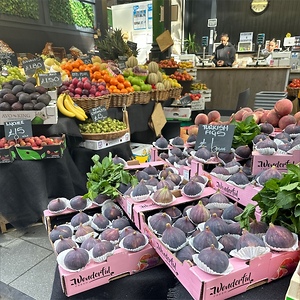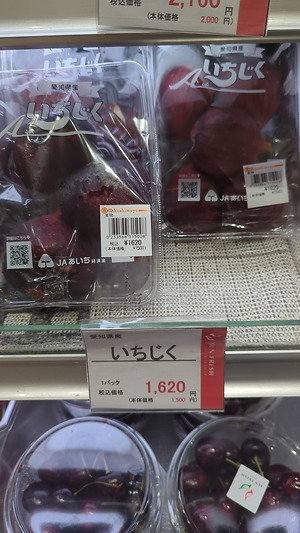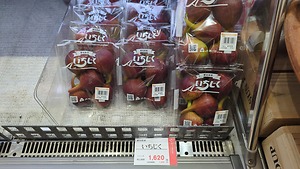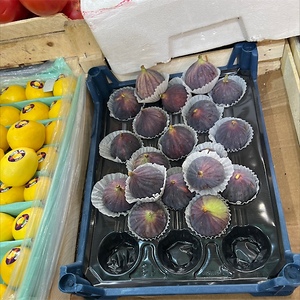

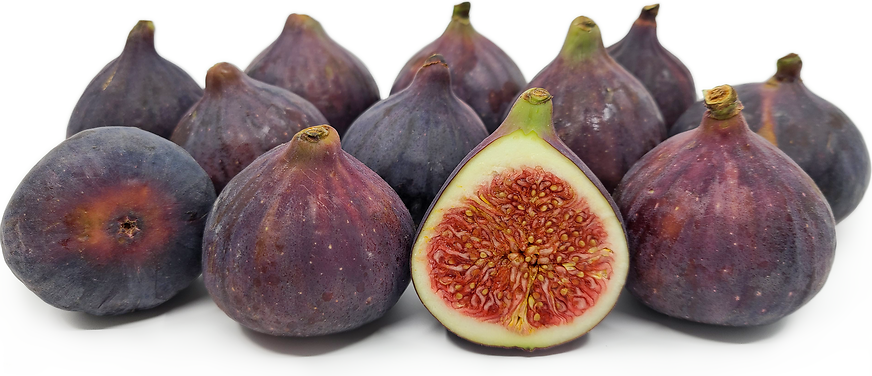
Bursa Figs
Estimated Inventory, 1 Lb : 0
Description/Taste
Bursa figs are a large varietal, averaging 4 to 7 centimeters in diameter, and have a round to teardrop shape bulbous appearance. The broad, curved base narrows towards the stem, and the figs are generally firm with a slight give when gently pressed. The fruit’s surface is taut, smooth, and lightly ribbed, ranging in color from red-purple, purple-blue, to dark purple, almost appearing black, and displays a small opening at the base of the fruit covered by brown scales. Figs are technically a syconium or a fleshy, hollow vessel containing a mass of tiny flowers. Underneath the thick skin, the flowers are enveloped in a spongy pale green flesh and have a variegated ruby red to pink hue, speckled with golden-beige seeds. Bursa figs are fleshy, sticky, and tender with an aqueous, crunchy, and melting-like texture. The figs release a fragrant fruity and floral aroma and contain high sugar content mixed with acidity, contributing to the fruit’s sweet, balanced flavor. Bursa figs have a distinct jammy, sugary, tangy, and honeyed taste.
Seasons/Availability
Bursa figs are available in the late summer through mid-fall.
Current Facts
Bursa figs, botanically classified as Ficus carica, are a Turkish variety belonging to the Moraceae family. The large figs are famous for their size and flavor and are grown in a small region in Turkey, where the climate, soil, and growing conditions contribute to the fig’s distinct flavor. Bursa figs are also known as Black Bursa figs and Bursa Siyahi and are a type of Smyrna fig, meaning the trees require active pollination to produce fruits. In Turkey, male figs are hung from a rope or in permeable bags on female fig trees. In Bursa, there are very few male trees, and the male fruits are suspended from the female trees at least three times throughout the early summer to successfully pollinate the female fruits. This process is carefully planned and executed, and the most common male fig used comes from the caprifig. This type of fig is the home to a fig wasp, one of the most essential pollinators for fig trees. The fig wasp lives and breeds inside the caprifig fruits, and when the fig wasps emerge from the fig, they find another fig for breeding, thus pollinating the nearby Bursa figs. This lifecycle is critical to the production of Bursa figs, and with careful cultivation after pollination, the trees produce large, aromatic fruits in the early fall. Bursa figs are highly prized for their large size, honeyed flavor, and soft and crisp texture. The fruit’s tough, thick skin allows it to be exported internationally, and Bursa figs are considered one of the best specialty varieties, primarily eaten fresh, out of hand.
Nutritional Value
Bursa figs are an excellent source of potassium to balance fluid levels in the body, fiber to regulate the digestive tract, and calcium to protect bones and teeth. The fruits also provide vitamin C to strengthen the immune system while reducing inflammation, vitamin A to maintain healthy organ functioning, and other nutrients, including iron, phosphorus, vitamins K and B6, copper, and magnesium.
Applications
Bursa figs have a honey-sweet flavor well suited for fresh and cooked preparations. The large fruits are customarily consumed straight, out of hand, or they are tossed into salads, displayed on charcuterie boards, or stirred into grain bowls. Bursa figs have a neutral flavor allowing the fruits to be incorporated into sweet or savory culinary dishes, and the figs are also folded into raw fig bars, used as an edible topping over yogurt, or mashed over honeyed toast. In addition to fresh recipes, Bursa figs are popularly simmered into jams, jellies, and preserves or cooked into sauces for roasted meats. The fruits can also be transformed into a paste as filling for pudding, pies, other pastries, ice cream, tarts, and cakes. In Turkey, Bursa figs are baked and served with kaymak, a Turkish clotted cream, or they are dried, stuffed, and boiled in milk as a sweet dessert. The figs can also be dried and used as a flavoring in cookies, bars, and spreads. Bursa figs pair well with nuts such as walnuts, hazelnuts, almonds, and pistachios, fruits including blueberries, raspberries, pears, and oranges, herbs such as thyme, rosemary, and cilantro, cheeses including goat, smoked mozzarella, and blue, and spices such as nutmeg, cardamom, cloves, and cinnamon. Whole, unwashed Bursa figs will keep 1 to 2 days at room temperature and 3 to 5 days when stored in the refrigerator’s crisper drawer.
Ethnic/Cultural Info
Bursa figs are celebrated at the annual Black Fig Festival held in Osmangazi, a district in the fig’s native province of Bursa in Turkey. The festival has been held for over twenty years and takes place in September, one of the peak months of the Bursa fig harvest. During the festival, fig growers from all over Bursa proudly display their prized Bursa figs, and a panel visits each table to judge the fruits on appearance, size, and flavor. It is a great honor to win the fig judging contest, and Bursa figs are one of the most commercially produced figs in Turkey, valued for their sweet flavor and juicy, soft, and crunchy consistency. The festival also features food vendors selling homemade fig-infused jams, bread, cakes, and other culinary dishes, and folk dancers and live music are performed to provide entertainment throughout the day. One of the festival's most traditional and popular events is Turkish oil wrestling or Yagli Gures. Turkish oil wrestling is one of Turkey’s oldest sports and is a timed wrestling competition between two men for title and glory. Both competitors must be covered in oil, a practice believed to level the playing field as each opponent must use skill and precision rather than body weight and size. Historically, the wrestling matches were untimed, with some matches lasting for hours, but after a match lasted over a day, and both competitors passed away from complications and exhaustion, a time limit of 40 minutes was placed on each match. Yagli Gures can be traced back to 1346 during the Ottoman Empire, and the first matches consisted of soldiers fighting to the death.
Geography/History
Bursa figs are native to the Bursa Province of northwestern Turkey and are extensively cultivated for their large size, flavor, and texture. Figs have been grown in Turkey for thousands of years and originated in Western Asia, spread over time through trade routes and migrating peoples into Europe, Africa, and East Asia. Bursa figs are grown by a small grouping of farmers located throughout ten villages within the Bursa Province, and the figs thrive in mild and warm, temperate climates. Most of these growers are a part of the Bursa Black Fig Grower Union, a cooperative established to help cultivate, transport, and market Bursa figs for the fresh eating sector. The union is made up of approximately 173 growers, and on average, produces anywhere between 10,000 to 16,000 tons of Bursa figs annually. Bursa figs also received a geographical indication, or GI, which identifies that the Bursa figs grown in the Bursa Province are distinct due to specific terroir and growing conditions only found in Bursa. Today Bursa figs are grown in Turkey and are exported fresh and dried to Europe, South Africa, Asia, Australia, and North America. When in season, the figs are found through local markets and retailers in Turkey and through specialty grocers and distributors worldwide.
Recipe Ideas
Recipes that include Bursa Figs. One
| Mindful Chef |
|
Chicken with Balsamic Roasted Fig Chutney & Salad |



